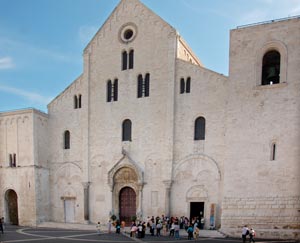
December is the time of year when many parents must decide how to answer the age- old question “ Is Santa real?” Children earnestly look their parents straight in the eye, but is it really the truth they want? And parents are usually not quite ready to replace Santa’s magical mystique with grown-up reality when the question arises for the first time.
Although Santa has become the most commercial symbol of the holidays, he is still a kind and benevolent figure. Santa patiently listens to those long wish lists and then promptly delivers the bounty on Christmas morning. And Santa remains jolly throughout a very stressful season.

Basilica of San Nicola, Bari, Italy
Santa’s admirable qualities were based on the real Saint Nicholas, the bishop of Myra, who lived around the fourth century in what is now southern Turkey. Nicholas, even before he was the bishop, helped people when they were really in need, not when they offered up a wish list. He protected the weak and anyone unjustly accused. He became the patron saint of children as well as to young maidens on the threshold of marriage, especially those who could not afford dowries. Miracles were credited to him hundreds of years after his death.
By the 11th century, Myra had lost interest in the esteemed saint, but his legend grew throughout Europe, especially in southern Italy. Back then, every major Italian city seemed to be acquiring the relics of saints: Andrew in Amalfi, Mark in Venice, Bartholomew in Benevento. The residents of Bari, Italy, proposed an unseemly plan to steal the bones of Saint Nicholas and bring them to the seaport city. In 1087, on a return voyage from Syria, 62 Bari sailors made a little pit stop in Myra and smuggled Saint Nicholas’ remains aboard their ship.
While our American Santa has become somewhat tarnished through crass commercialism, the real Saint Nicholas is still revered and honored in Bari, even if his relocation to the city was a tad devious.
The Basilica of San Nicola is an active church, and Mass is said daily in the crypt where Saint Nicholas’s relics are entombed. People come from all over the world to pray for his intercessions, especially when they are in a tough spot. They believe strongly in the goodness and generosity of Saint Nicholas and that his spirit still exists in the world today.
In 1897, New York newsman Francis Pharcellus Church responded to a little girl named Virginia, who asked if Santa really existed. “The most real things in the world are those that neither children nor men can see… He [Santa] exists as certainly as love and generosity and devotion exist,” Church wrote. I can’t say it any better than Church when he penned his classic editorial, “Yes Virginia, there is a Santa Claus.”
This year, let our hearts and actions be filled with love and generosity as exemplified by the real Saint Nicholas who helped those in need. And then we can answer truthfully that “Yes, Santa is real.”
Happy Holidays,






